2002 MERCEDES-BENZ G500 wheel
[x] Cancel search: wheelPage 327 of 385
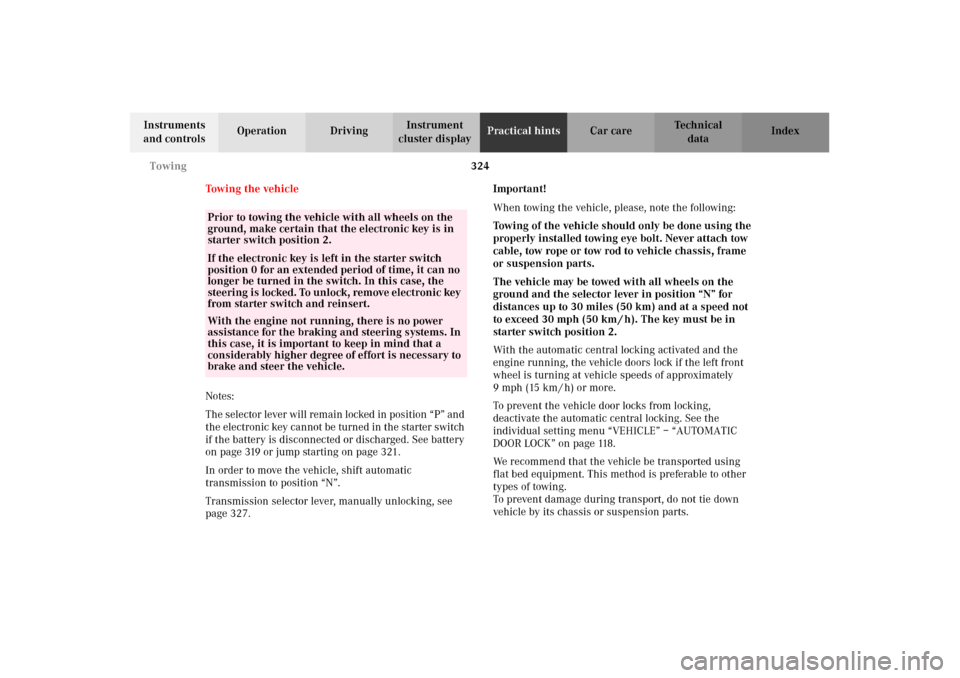
324 Towing
Te ch n i c a l
data Instruments
and controlsOperation DrivingInstrument
cluster displayPractical hintsCar care Index
Towing the vehicle
Notes:
The selector lever will remain locked in position “P” and
the electronic key cannot be turned in the starter switch
if the battery is disconnected or discharged. See battery
on page 319 or jump starting on page 321.
In order to move the vehicle, shift automatic
transmission to position “N”.
Transmission selector lever, manually unlocking, see
page 327.Important!
When towing the vehicle, please, note the following:
Towing of the vehicle should only be done using the
properly installed towing eye bolt. Never attach tow
cable, tow rope or tow rod to vehicle chassis, frame
or suspension parts.
The vehicle may be towed with all wheels on the
ground and the selector lever in position “N” for
distances up to 30 miles (50 km) and at a speed not
to exceed 30 mph (50 km / h). The key must be in
starter switch position 2.
With the automatic central locking activated and the
engine running, the vehicle doors lock if the left front
wheel is turning at vehicle speeds of approximately
9 mph (15 km / h) or more.
To prevent the vehicle door locks from locking,
deactivate the automatic central locking. See the
individual setting menu “VEHICLE” – “AUTOMATIC
DOOR LOCK” on page 118.
We recommend that the vehicle be transported using
flat bed equipment. This method is preferable to other
types of towing.
To prevent damage during transport, do not tie down
vehicle by its chassis or suspension parts.
Prior to towing the vehicle with all wheels on the
ground, make certain that the electronic key is in
starter switch position 2.If the electronic key is left in the starter switch
position 0 for an extended period of time, it can no
longer be turned in the switch. In this case, the
steering is locked. To unlock, remove electronic key
from starter switch and reinsert.
With the engine not running, there is no power
assistance for the braking and steering systems. In
this case, it is important to keep in mind that a
considerably higher degree of effort is necessary to
brake and steer the vehicle.
J_G463.book Seite 324 Mittwoch, 19. September 2001 8:06 08
Page 329 of 385
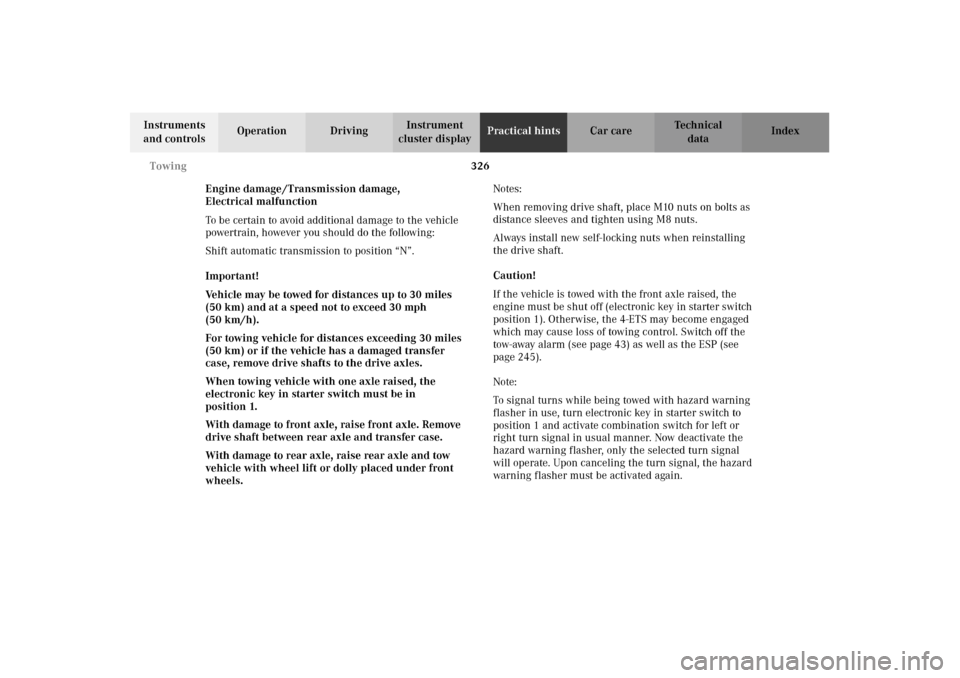
326 Towing
Te ch n i c a l
data Instruments
and controlsOperation DrivingInstrument
cluster displayPractical hintsCar care Index
Engine damage /Transmission damage,
Electrical malfunction
To be certain to avoid additional damage to the vehicle
powertrain, however you should do the following:
Shift automatic transmission to position “N”.
Important!
Vehicle may be towed for distances up to 30 miles
(50 km) and at a speed not to exceed 30 mph
(50 km/h).
For towing vehicle for distances exceeding 30 miles
(50 km) or if the vehicle has a damaged transfer
case, remove drive shafts to the drive axles.
When towing vehicle with one axle raised, the
electronic key in starter switch must be in
position 1.
With damage to front axle, raise front axle. Remove
drive shaft between rear axle and transfer case.
With damage to rear axle, raise rear axle and tow
vehicle with wheel lift or dolly placed under front
wheels.Notes:
When removing drive shaft, place M10 nuts on bolts as
distance sleeves and tighten using M8 nuts.
Always install new self-locking nuts when reinstalling
the drive shaft.
Caution!
If the vehicle is towed with the front axle raised, the
engine must be shut off (electronic key in starter switch
position 1). Otherwise, the 4-ETS may become engaged
which may cause loss of towing control. Switch off the
tow-away alarm (see page 43) as well as the ESP (see
page 245).
Note:
To signal turns while being towed with hazard warning
flasher in use, turn electronic key in starter switch to
position 1 and activate combination switch for left or
right turn signal in usual manner. Now deactivate the
hazard warning flasher, only the selected turn signal
will operate. Upon canceling the turn signal, the hazard
warning flasher must be activated again.
J_G463.book Seite 326 Mittwoch, 19. September 2001 8:06 08
Page 330 of 385
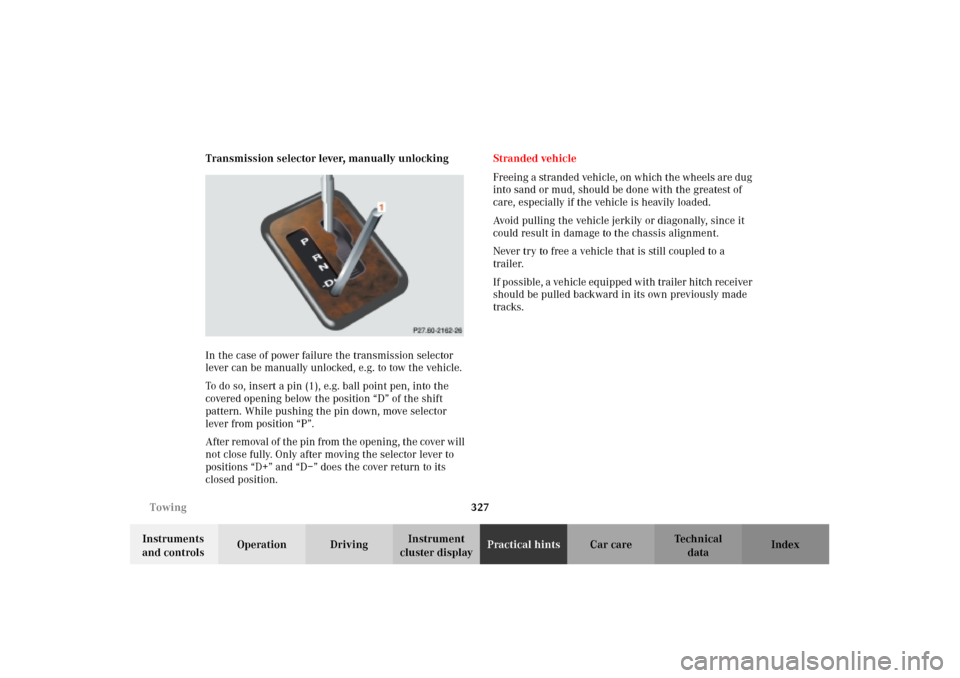
327 Towing
Te ch n i c a l
data Instruments
and controlsOperation DrivingInstrument
cluster displayPractical hintsCar care Index Transmission selector lever, manually unlocking
In the case of power failure the transmission selector
lever can be manually unlocked, e.g. to tow the vehicle.
To do so, insert a pin (1), e.g. ball point pen, into the
covered opening below the position “D” of the shift
pattern. While pushing the pin down, move selector
lever from position “P”.
After removal of the pin from the opening, the cover will
not close fully. Only after moving the selector lever to
positions “D+” and “D–” does the cover return to its
closed position.Stranded vehicle
Freeing a stranded vehicle, on which the wheels are dug
into sand or mud, should be done with the greatest of
care, especially if the vehicle is heavily loaded.
Avoid pulling the vehicle jerkily or diagonally, since it
could result in damage to the chassis alignment.
Never try to free a vehicle that is still coupled to a
trailer.
If possible, a vehicle equipped with trailer hitch receiver
should be pulled backward in its own previously made
tracks.
J_G463.book Seite 327 Mittwoch, 19. September 2001 8:06 08
Page 352 of 385

349 Contents - Car care
Te ch n i c a l
data Instruments
and controlsOperation DrivingInstrument
cluster displayPractical hintsCar careIndex
Vehicle careCleaning and care
of the vehicle .............................350
Power washer .............................. 351
Tar stains ..................................... 351
Paintwork, painted body
components ................................. 351
Engine cleaning ..........................352
Vehicle washing .........................352
Ornamental moldings ................352
Headlamps, taillamps,
turn signal lenses ......................352Window cleaning ....................... 353
Wiper blades .............................. 353
Light alloy wheels ..................... 353
Instrument cluster ..................... 353
Steering wheel and
gear selector lever ..................... 353
Cup holder .................................. 354
Seat belts ..................................... 354
Headliner .................................... 354
Upholstery .................................. 354
Hard plastic trim items ............. 354
Plastic and rubber parts ........... 354
J_G463.book Seite 349 Mittwoch, 19. September 2001 8:06 08
Page 355 of 385
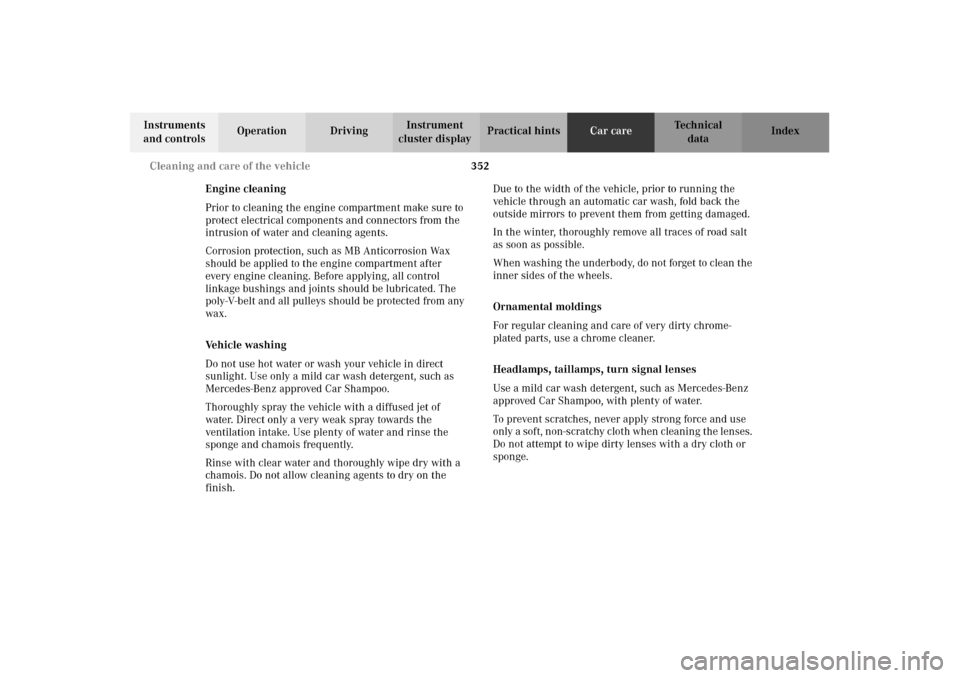
352 Cleaning and care of the vehicle
Te ch n i c a l
data Instruments
and controlsOperation DrivingInstrument
cluster displayPractical hintsCar careIndex
Engine cleaning
Prior to cleaning the engine compartment make sure to
protect electrical components and connectors from the
intrusion of water and cleaning agents.
Corrosion protection, such as MB Anticorrosion Wax
should be applied to the engine compartment after
every engine cleaning. Before applying, all control
linkage bushings and joints should be lubricated. The
poly-V-belt and all pulleys should be protected from any
wax.
Vehicle washing
Do not use hot water or wash your vehicle in direct
sunlight. Use only a mild car wash detergent, such as
Mercedes-Benz approved Car Shampoo.
Thoroughly spray the vehicle with a diffused jet of
water. Direct only a very weak spray towards the
ventilation intake. Use plenty of water and rinse the
sponge and chamois frequently.
Rinse with clear water and thoroughly wipe dry with a
chamois. Do not allow cleaning agents to dry on the
finish.Due to the width of the vehicle, prior to running the
vehicle through an automatic car wash, fold back the
outside mirrors to prevent them from getting damaged.
In the winter, thoroughly remove all traces of road salt
as soon as possible.
When washing the underbody, do not forget to clean the
inner sides of the wheels.
Ornamental moldings
For regular cleaning and care of very dirty chrome-
plated parts, use a chrome cleaner.
Headlamps, taillamps, turn signal lenses
Use a mild car wash detergent, such as Mercedes-Benz
approved Car Shampoo, with plenty of water.
To prevent scratches, never apply strong force and use
only a sof t, n on -s cratchy c lot h when c lean in g t he len ses .
Do not attempt to wipe dirty lenses with a dry cloth or
sponge.
J_G463.book Seite 352 Mittwoch, 19. September 2001 8:06 08
Page 356 of 385
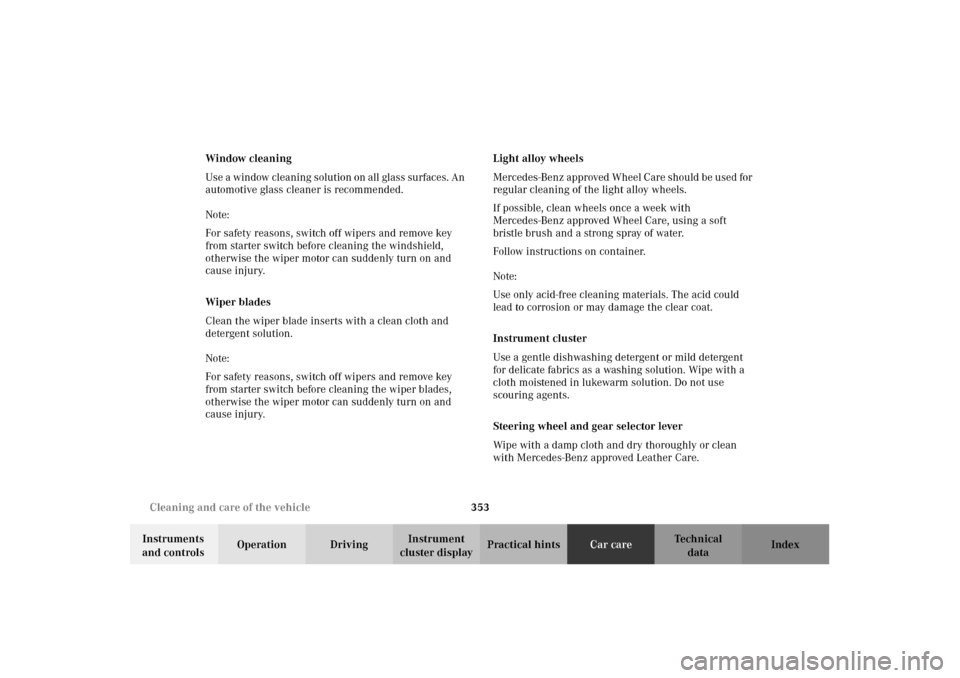
353 Cleaning and care of the vehicle
Te ch n i c a l
data Instruments
and controlsOperation DrivingInstrument
cluster displayPractical hintsCar careIndex Window cleaning
Use a window cleaning solution on all glass surfaces. An
automotive glass cleaner is recommended.
Note:
For safety reasons, switch off wipers and remove key
from starter switch before cleaning the windshield,
otherwise the wiper motor can suddenly turn on and
cause injury.
Wiper blades
Clean the wiper blade inserts with a clean cloth and
detergent solution.
Note:
For safety reasons, switch off wipers and remove key
from starter switch before cleaning the wiper blades,
otherwise the wiper motor can suddenly turn on and
cause injury.Light alloy wheels
Mercedes-Benz approved Wheel Care should be used for
regular cleaning of the light alloy wheels.
If possible, clean wheels once a week with
Mercedes-Benz approved Wheel Care, using a soft
bristle brush and a strong spray of water.
Follow instructions on container.
Note:
Use only acid-free cleaning materials. The acid could
lead to corrosion or may damage the clear coat.
Instrument cluster
Use a gentle dishwashing detergent or mild detergent
for delicate fabrics as a washing solution. Wipe with a
cloth moistened in lukewarm solution. Do not use
scouring agents.
Steering wheel and gear selector lever
Wipe with a damp cloth and dry thoroughly or clean
with Mercedes-Benz approved Leather Care.
J_G463.book Seite 353 Mittwoch, 19. September 2001 8:06 08
Page 362 of 385
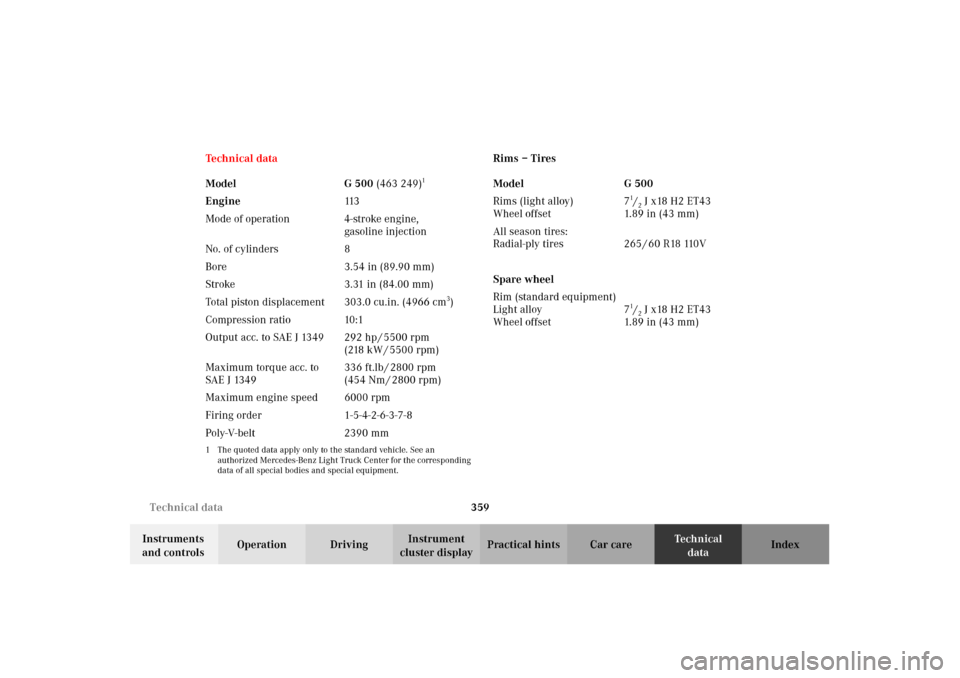
359 Technical data
Te ch n i c a l
data Instruments
and controlsOperation DrivingInstrument
cluster displayPractical hints Car care Index Te ch n i c a l d a t aRims – Tires
Model G 500 (463 249)
1
Engine113
Mode of operation 4-stroke engine,
gasoline injection
No. of cylinders 8
Bore 3.54 in (89.90 mm)
Stroke 3.31 in (84.00 mm)
Total piston displacement 303.0 cu.in. (4966 cm
3)
Compression ratio 10:1
Output acc. to SAE J 1349 292 hp / 5500 rpm
(218 kW / 5500 rpm)
Maximum torque acc. to
SAE J 1349336 ft.lb / 2800 rpm
(454 Nm / 2800 rpm)
Maximum engine speed 6000 rpm
Firing order 1-5-4-2-6-3-7-8
Poly-V-belt 2390 mm
1 The quoted data apply only to the standard vehicle. See an
authorized Mercedes-Benz Light Truck Center for the corresponding
data of all special bodies and special equipment.
Model G 500
Rims (light alloy)
Wheel offset7
1/2 J x18 H2 ET43
1.89 in (43 mm)
All season tires:
Radial-ply tires 265 / 60 R18 110V
Spare wheel
Rim (standard equipment)
Light alloy
Wheel offset7
1/2 J x18 H2 ET43
1.89 in (43 mm)
J_G463.book Seite 359 Mittwoch, 19. September 2001 8:06 08
Page 363 of 385

360
Technical \fata
Te ch n i c a l
\fata
In\btrument\b
an\f control\b Operation Driving
In\btrument
clu\bter \fi\bplay Practical hint\b Car care In\fex
Electrical \by\btem
Vehicle weight\b an\f rating\b
Gr\fss Vehicle Weight Rating (GVWR) is the maximum
\bermissible vehicle weight: 6615 lbs. (3000 kg)
Gr\fss Vehicle Weight (GVW): c\fm\brises weight \ff
vehicle including fuel, t\f\fls, s\bare wheel, installed
access\fries, \bassengers, carg\f and trailer t\fngue. It
must never exceed the GVWR.
Gr\fss Axle Weight Rating (GAWR) is the maximum
\bermissible axle weight: Main \fimen\bion\b
Mo\fel G 500
Generat\fr (alternat\fr) 14 V / 150 A
Starter m\ft\fr 12V / 1.7 kW
B
att ery 12 V /9 0 A h
S\bark \blugs
Electr\fde ga\b
Tightening t\frque B\fsch F 8 DPER
Beru 14 FGH 8 DPUR X 2
0.039 in (1.0 mm)
15–22ft.lb (20–30Nm)
fr\fnt
rear 3110 l b s .
3965 lbs. ( 1410 k g )
(1800 kg)
Wa r n i n g !Do not loa\f item\b on the roof. It may cau\be
in\btability \furing \bome maneuver\b which coul\f
re\bult in an acci\fent.
Mo\fel G 500
Overall vehicle length
(inc. s\bare wheel) 185.6 in (4715 mm)
Overall vehicle width
(inc. rear view mirr\frs) 79.0
in (2 007 m m)
O ver all h eig h t 77.85 i n ( 1 9 77 m m )
Wheel base 112.2 in (2850 mm)
Gr\fund clearance 8.3 in (211 mm)
Turning radius 523.6 in (13.3 m)
Track, fr\fnt 59.6 in (1515 mm)
Track, rear 59.6 in (1515 mm)
J_G463.book Seite 360 Mittwoch, 19. September 2001 8:06 08